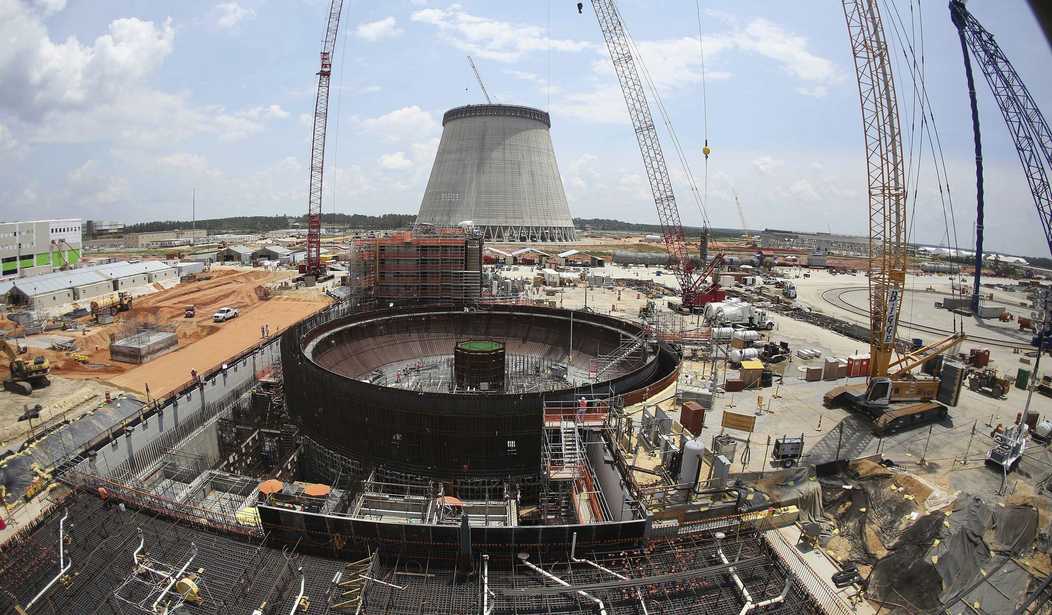Just a month ago, Georgia Power announced that its Vogtle nuclear reactor Unit 3 had started a nuclear reaction inside the reactor – meaning that the nuclear fission process has begun splitting toms and generating heat. Unit 3 is expected to be fully operational in May or June, with Unit 4 scheduled to go online in the fall.
Currently, Units 1 and 2 at the Alvin W. Vogtle Electric Generating Plant, which went online in 1987 and 1989, respectively, have a combined capacity of 2,430 megawatts. The two new units will double capacity and theoretically enable Georgia Power to produce nearly 40 million megawatt-hours of electricity for end users; the two existing units cranked out 19,515.206 MWh in 2022.
Georgia has no production of oil, natural gas, or coal, but thanks to pipelines, natural gas consumption has nearly tripled since 2010 and now accounts for almost half of the state’s net electricity generation. Overall, Georgia households pay an average 11.17 cents per kilowatt-hour for electricity, less than half that paid by California residents.
Nuclear power currently supplies slightly more than half of the state’s primary energy production, with the rest coming from renewable resources, specifically biomass, solar energy, and hydropower. The two nuclear plants supply another 25 percent, but the increase is much needed in a state that already uses more energy than it produces.
When Vogtle Unit 4 goes online this fall, the U.S. will have 94 operating reactors that collectively generate a fifth of the nation’s electricity – and half of the nation’s so-called “clean” (carbon-free) electricity. Unlike intermittent wind and solar, however, nuclear energy is reliable regardless of weather conditions and does not need backup generation capacity.
Recommended
That’s the upside. The downside is that most of these reactors were built prior to 1990. Even though the nuclear accident at Three Mile Island in Pennsylvania was relatively insignificant, the fear it generated (despite no known health impacts) resulted in the cancellation of 67 reactor construction projects from 1979 through 1988. The only other new reactor brought online in the U.S. in the past 20 years was Watts Bar Unit 2 in Tennessee in 2016.
The Nuclear Energy Institute has lauded the Biden Administration’s decision to rekindle public support for nuclear energy (over loud objections from some in the environmental community). Calling 2022 a “big year” for nuclear energy, the NEI noted major public policy wins that “will change the landscape of clean energy deployment.” They also claimed “real progress in raising awareness in the value of nuclear energy among climate groups, investors, and others.
The Inflation Reduction Act (IRA), the NEI noted, “unleashed an unprecedented opportunity for increased public-private investment in nuclear energy.” The bill includes a Production Tax Credit for existing nuclear plants, an Investment Tax Credit for new zero-emission facilities, and a partial investment in establishing a reliable supply of high-assay, low-enrichment (HALEU) fuel for next-generation nuclear plants.
Too, the Department of Energy says the nuclear power industry made “major strides” in 2022, and that, thanks to the IRA and the Bipartisan Infrastructure Law (BIL), that momentum is expected to carry over into 2023. Just for the Vogtle project, the DOE’s Loan Programs Office allocated more than $12 billion in loan guarantees.
The IRA also designated $500 million to help jumpstart the acquisition of inventory for high-assay, low-enriched uranium (HALEU) production to support several advanced nuclear reactor demonstration projects. The DOE is also partnering with American Centrifuge Operating to demonstrate HALEU production at its enrichment facility in Piketon, Ohio.
As for those advanced reactor projects, TerraPower and X-energy are now expected to submit construction permit applications to the Nuclear Regulatory Commission within a year. TerraPower is developing a Natrium reactor, a sodium-cooled fast reactor to be located near a retiring coal plant in Wyoming. X-energy is evaluating sites for its Xe-100 high-temperature gas small modular reactor (pebble-bed) plant.
The DOE was also granted $6 billion under the BIL for the Civil Nuclear Credit Program. The first conditional credits under this program went to Pacific Gas and Electric Company to extend the life of the Diablo Canyon nuclear plant in California, which was earlier scheduled for decommissioning. But one environmental group has thrown paint onto the “changing landscape.”
To grease the wheels for keeping Diablo Canyon open, the Nuclear Regulatory Commission a month ago determined PG&E could continue operating Diablo Canyon past 2025 while the utility works through the relicensing process. Federal and state officials both urged PG&E to extend the reactor’s operating life through 2030 because of California’s energy crisis.
However, Friends of the Earth (FOE) this week filed a lawsuit demanding that Diablo Canyon be shut down by 2025, as PG&E had agreed to do under a 2016 contract agreement. That contract agreement was signed in exchange for FOE dropping a lawsuit over environmental and public safety concerns at the plant. FOE also argues that PG&E failed to follow federal regulations that required filing renewal applications at least 5 years before their current license expires.
FOE may win its lawsuit and thwart the Save California plan – the grandiose plan to force Golden Staters to rely solely on wind and solar (with a smidgeon of hydro and geothermal) – except, of course, for energy they import from other states. But researchers at the Massachusetts Institute of Technology (MIT) now claim there is another factor to consider in weighing the future of nuclear energy – the impact on air pollution.
The MIT team laid out a scenario in which all 94 U.S. nuclear power plants shut down and pondered how other sources – coal, natural gas, renewables – would be used to replace the 20 percent of U.S. electricity generation supplied by those plants. Their conclusion was that air pollution would rise because coal, gas, and oil would fill in enough of the gap to result in an additional 5,200 pollution-related deaths a year.
That has been the pattern in the past in the U.S. and is the pattern today in Europe. In 1985, the MIT study pointed out, the closure of reactors in the Tennessee Valley prompted a spike in coal use. The shutdown of the San Onofre Nuclear Generating Station in California a decade ago led to increased reliance on natural gas. Just last year, Germany began reopening coal-fired power plants after earlier substituting Russian natural gas for the energy lost due to closure of its nuclear power plants.
Early on, the revitalized support for nuclear energy by the Biden Administration was dubbed a “cautious embrace” by the Voice of America. Energy Secretary Jennifer Granholm admitted “we have to find ways” to keep nuclear power plants open in order to achieve our climate goals.
And in a rare admission that reflects reality, the DOE admitted it takes 3 million solar panels or 400-plus wind turbines to produce the same power as a single 1-gigawatt reactor. With the four Vogtle units collectively generating nearly 5 gigawatts, replacing them would require 15 million solar panels or 2,000 wind turbines – just to provide a portion of the energy that Georgia needs.
But solar panels and wind turbines last a maximum 20 years, while nuclear facilities have an 80-year lifespan. So the real number is 12 million solar panels, or 1,600 wind turbines, per gigawatt of nuclear energy.
Nationwide, the nation’s 94 nuclear reactors collectively generate nearly 100 gigawatts of electricity. To replace all this energy over an 80-year lifespan, America would have to purchase 1.2 billion mostly Chinese-made solar panels or build 160,000 wind turbines.
The toxic and other waste that would be generated by that many discarded solar panels and turbine blades boggles the mind. The attractiveness of nuclear – with a much smaller footprint and much less waste to manage – has never been so obvious.
Duggan Flanakin is a senior policy analyst for the Committee for a Constructive Tomorrow and a frequent writer on public policy issues.

























Join the conversation as a VIP Member